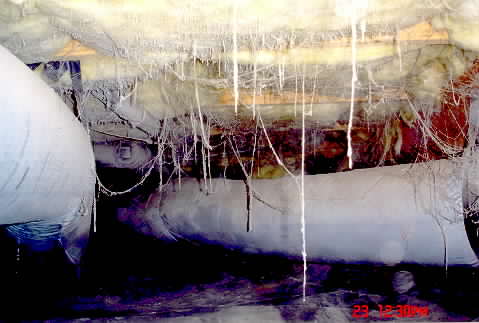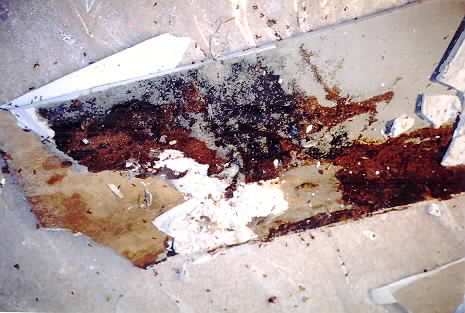|
||||
|
|
|
|||
| Home | Subscribe | Back Issues | The Organization | Volunteer | Do Something | ||||
|
||||
|
Is it safe to buy a home in WA? Home inspectors are not required to report toxic mold personal account by T. McCormick
After purchasing a 12-year-old home in 2003 in western Washington, I became sadly aware of the gaps in state protection of our health and welfare in home purchases. For renters, Washington issued a Landlord-Tenant Act Mold Information booklet in 2005, designed to protect tenants from the effects of toxic mold. Homebuyers might expect that home inspectors, who examine buildings and write reports prior to a sale, would be on the lookout for toxic mold. But after buying my house, I found widespread mold that should have been obvious in the inspection, as well as other code problems. A shower was exhausting into the attic. Adjacent sheeting and trusses were completely black with mold in this area and the sheeting showed areas of soft rot. Some 1,000 square feet of very visible black mold found in my attic sheeting, associated with multiple areas of soft rot, was never reported to me by the home inspector who inspected my house prior to my buying it.
The specific mold was Chaetomium, which is well known for causing soft rot in houses, though it does not affect living trees. Chaetomium is one of the three most dangerous molds found in homes according to the website mold-help.org. In the crawl space there were areas of effervescence where water pooled against the foundation--and yet more mold. For over a year I suffered from a rash, cough, sinusitis and bloody noses of unknown etiology. I have recently been diagnosed with adult-onset asthma as well as neurological damage. I have reduced lung capacity and an enlarged thyroid gland, which has displaced my esophagus to the point that it is now difficult to swallow. I suffer from chronic fatigue and immunosupression. My blood pressure, formerly quite low, spikes continually and I suffer from severe electrical-shock-like sensations in my legs. I am not alone, as can be noted on mold-help.org, mold-survivor.com or medhelp.org/forums/thyroid. Concerned about my health, and considering that the home inspector must have acted improperly in not reporting the mold problem, I contacted a state investigator in the office charged with overseeing home inspectors. The state investigator took a look at my mold-filled attic and said to me "Don't get into that mold remediation crap." Although he privately acknowledged the presence of the mold, he refused to document it in his report. Since then I learned that home inspectors in Washington are--amazingly--not actually required to report mold if they see it. The Washington State Department of Agriculture (WSDA) Guidance Document for Structural Pest Inspectors claim that mold and mildew does not cause wood rot, and so does not need to be reported because there are no structural concerns. It also--in apparent contradiction--refers inspectors to the federal EPA website, which basically states that mold and mildew rot everything they grow on and should be removed. One reason that the WSDA can get away with ignoring mold is that the US Forest Service asserts that mold and mildew do not cause wood rot. Washington state Senator Adam Smith is investigating this discrepancy between the Forest Service and EPA policies.
As far as personal health is concerned, the effects of mold and the phenomenon of "sick building syndrome" have been widely noted for years, but the health issue can apparently be roundly ignored by home inspectors. In Washington, there are fortunately a couple great resources on toxic mold. Harriet Ammann, PhD, the senior toxicologist for the Washington Department of Health, discusses the health effects of mold in the pamphlet "Is Indoor Mold Contamination a Threat to Health?" (see www.healthylivingfoundation.org/PDF/AmmannMold.pdf ). Amman is also one of four authors for the American Society of Microbiology statement on "Microorganisms, Mold and Indoor Air Quality." Anne Steinemann of the University of Washington lists dust and mold as major health topics to tackle in various articles she has written, available online. What does this all mean? Many experts are aware of the health risks, so why the apparent disconnect in Washington State between health experts and the department that oversees and teaches home inspection? Do we need immediate changes in the laws? Following are some suggestions.
1. Often mold is caused by poor, sub-code original construction. Builders in this state are free and clear from fraud charges after only three years. Other states hold builders accountable for fraud from the time of discovery. We should do the same. 2. Why are realtors allowed to recommend inspectors when this produces a conflict of interest? The inspectors tend to give "passing" inspections in order to get continued recommendations from realtors. Inspectors who are concerned about problems such as mold will ruin or delay sales for the realtor, and will not get as many referrals. Many states rightly do not allow realtor recommendations of inspectors. In Washington, we could implement the same policy, and also restrict contact between inspectors and sellers, who might mislead or influence inspectors. 3. Does the oversight for home inspection need to be removed from the Washington Department of Agriculture, which appears to be fraught with misinformation concerning mold and wood rot? Perhaps a citizen board or public health officials should oversee this. 4. Do we need a data base available to the public, in which inspectors who find large amounts of mold in a home can list that home as a danger until the seller can show proof of remediation by inspection? Something similar exists through the "Clue Report" for insurance claims. 5. Some black molds--such as Chaetomium--are more damaging to health and building structure, but identifying an exact variety of black mold is impossible with a visual inspection. For this reason, all black molds and the extent of growth should be reported on inspection reports, and homeowners and lenders should then have the option of calling for a mold analysis and possible remediation.* |
|


